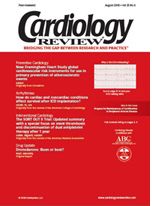Mortality, morbidity, and new-onset diabetes reduced with combination hypertension treatment
Hypertension
Orlando—Treatment with a calcium channel blocker and an angiotensin-converting enzyme (ACE) inhibitor significantly reduces cardiovascular mortality and events compared with treatment with a beta blocking agent and diuretic combination, according to preliminary results of the Blood Pressure-Lowering Arm of the Anglo-Scandinavian Cardiac Outcomes Trial (ASCOT-BPLA).
All coronary events were reduced by 15%, stroke by 25%, cardiovascular mortality by 25%, and all-cause mortality by 15% with the calcium channel blocker and ACE inhibitor combination, said Peter S. Sever, MD, Imperial College, London. “This is certainly a finding we would not have predicted,” he said during the American College of Cardiology Annual Scientific Session 2005.
“The other important result was confirmation that treatment with a beta blocker and diuretic increases the likelihood of developing diabetes,” Dr. Sever said. In ASCOT-BPLA, new-onset diabetes was increased by 30% among patients receiving the beta blocker and diuretic combination compared with patients receiving a calcium channel blocker and ACE inhibitor.
While beta blockers are clearly indicated in certain hypertension patient subgroups, such as those with a prior myocardial infarction (MI) or symptomatic coronary heart disease (CHD), the ASCOT-BPLA data raise questions about the position of beta blockers in treating uncomplicated hypertension, Dr. Sever said.
The trial randomized 19,342 patients aged 40 to 79 years with treated or untreated systolic blood pressure greater than 140 mm Hg or untreated diastolic blood pressure greater than 100 mm Hg or treated diastolic pressure greater than 90 mm Hg. All patients had at least three cardiovascular risk factors in addition to hypertension.
Patients received either 5 or 10 mg of amlodipine (Norvasc) with or without 4 to 9 mg of perindopril (Aceon) daily or 50 to 100 mg of atenolol (Tenormin) with or without 1.25 to 2.5 mg bendroflumethiazide plus potassium (Diuril, Esidrix). Doses were increased and second agents added as required to reach the target blood pressure of less than 140 mm Hg systolic and less than 90 mm Hg diastolic. “This was a trial designed to look at treatment strategy rather than an individual drug because we recognized that most patients would require two drugs to achieve target pressures,” Dr. Sever said.
Primary end points were nonfatal MI and fatal CHD; mean follow-up was 5.5 years in November 2004, when the trial was halted by the data safety monitoring board because all-cause mortality was 15% lower among patients in the calcium channel blocker plus ACE inhibitor arm. “We didn’t power the study to predict all-cause mortality so this was a striking and important result,” Dr. Sever said.
Primary end points were reduced by a nonsignificant 10% when the trial was halted. However, only 850 cases of nonfatal MIs or fatal CHD had occurred at this time, and the trial was powered to detect a significant difference between treatment groups with an expected 1,150 primary events, Dr. Sever said. “But when we looked at all the other prespecified end points of coronary events, stroke, and cardiovascular mortality, the differences were highly significant.”
While these results are preliminary, they represent 95% of all the ASCOT-BPLA data and no differences are expected with the final results, Dr. Sever said.
